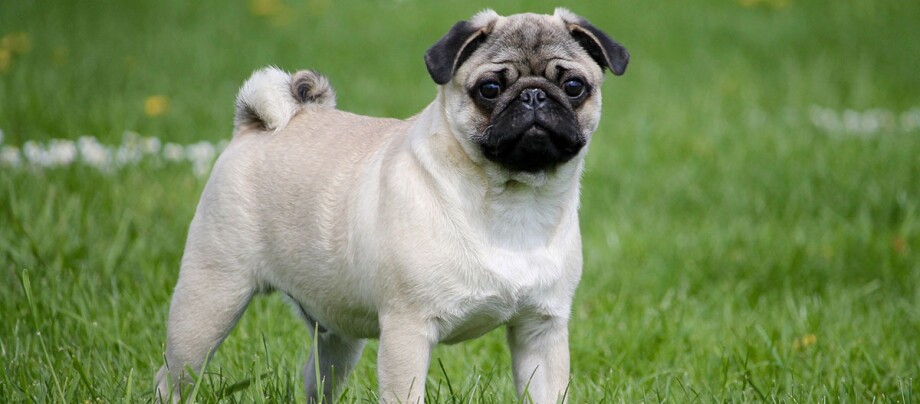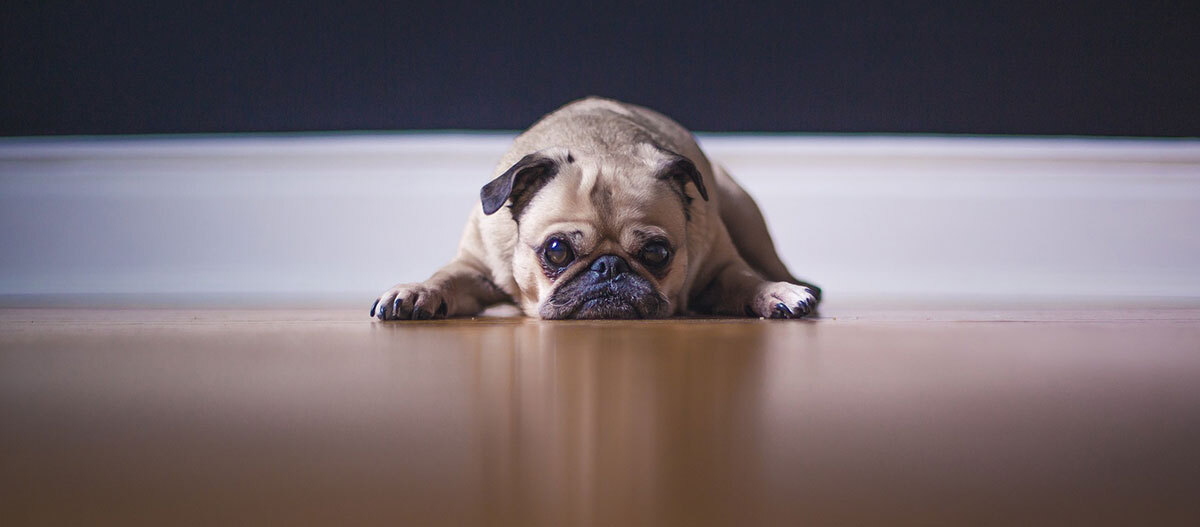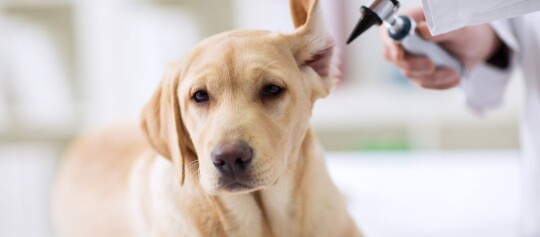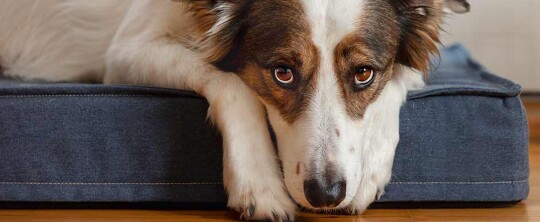The Pug – a four-legged aristocratic charmer
18.02.2024 - Reading time: 9 minutes

“Life without a pug is possible, but pointless,” said Loriot And for good reason: The Pug is a lively, charming and loyal companion, yet loving and affectionate. You cannot resist its scrunchy face and big eyes. But do not be fooled: pugs know how to pull out all the stops to wrap their humans around their paws.
- The emperor's dog
- What is the Pug’s temperament like?
- Pug profile
- Is the Pug suitable for first-time owners?
- How much exercise does a Pug need?
- What does a Pug look like?
- What does an Old German Pug look like?
- What is a Retro Pug?
- Health and caring for a Pug
- How much does a Pug cost?
- Important note about the breed
The emperor’s dog
The Pug is an aristocratic dog. It can be traced back to 2000 years ago in China, where as the ‘emperor’s dog’, it was only allowed to be kept by monarchs. Pugs were brought to Europe from the Far East in the 16th century by Dutch merchants. Here they also soon became incredibly popular within aristocratic circles – Queen Victoria, for example, kept an entire pack of Pugs. When the Queen decided to add some Pugs to her pack of dogs in 1857, it was not easy to find any. She even sent an English envoy to Germany. But even there the search proved difficult. The first Pug that the queen finally managed to get was called Bosco. He was followed by 37 more Pugs.
Pugs quickly came into vogue, as they were seen as a fashionable pet by the women of high society. At the same time, however, the breed began to degenerate. Due to the Pug being treated as a living accessory for these ladies’ salons, it did not live the kind of life that a dog ought to live. The Pug faded from popularity towards the end of the 19th century; however, it is currently experiencing a revival. There are many stories and legends about the Pug. For instance, the Pug Pompey is said to have saved the life of its owner, William I of Orange, with its loud barking. It is said that the dog’s barking allowed the prince to escape an assassin in time.
What is the Pug’s temperament like?
The Pug is a happy, even-tempered and lively breed. It may be small, but it is bold: compared to others of its kind, the Pug often suffers from delusions of grandeur and is very spirited. They are quick to underestimate dangers. This means that Pugs navigate the world with an inherent sense of trust and are sensitive to others’ moods. The Pug does not tolerate loneliness and always wants to be involved. It is therefore not suitable for life in a kennel and should absolutely be integrated into everyday family life. If it feels left out, it will make sure to let you know: it communicates with its owners using facial expressions, gestures and a range of grunts, snorts and grumbles. Pugs are intelligent dogs, but they can also be headstrong and occasionally stubborn. Consistent training is therefore essential, even for a Pug puppy.
NewsletterPug
Breed | Pug |
Origin | China |
Classification | Society and companion dog |
Size | up to 32 centimetres shoulder height |
Weight | 6.5 to 9 kg |
Physique | curled tail, short, round head, slight underbite, robust, compact build |
Eyes | slightly protruding
|
Ears | button or rose ears
|
Coat and colour | short, soft, sits close to the body; colours: beige, black, apricot, white or silver with a black face mask |
Special features | Sensitive to heat and physical exertion
|
Nature | affectionate, funny, brave and agile
|
Care | daily brushing, ears and skin folds require special care
|
Health | prone to respiratory and eye diseases
|
We have the best products for your pug!
Is the Pug suitable for first-time owners?
Standing up to 32 centimetres at shoulder height, the Pug is one of the ‘Mini Molossers’. It is not born to be an athlete or watchdog, but it is making a name for itself in other areas: it is a great companion dog, especially for elderly people. Its affectionate nature and need for physical contact make it a natural choice. Its small size means that it can live happily in a city or apartment. So, is the Pug an ideal dog for beginners? Yes, absolutely. The Pug is a good choice for first-time dog owners and gets on well with children and other pets.
How much exercise does a Pug need?
All dogs require a certain amount of exercise to stay fit and feel good. The same holds true for Pugs, although they are by no means natural athletes. This is because they do not handle physical exertion or heat well. So, if you are looking for a dog to join you for a jog or run alongside a bike, the Pug will not make a suitable companion. This breed is better suited to lower-octane forms of enjoyment such as extensive digging and romping. Pugs also enjoy water-based, balancing and retrieving games. They also love to clamber on to sofas and other high places. However, climbing stairs is not good for them; it is better to carry your little one and not let it climb the stairs on its own.
Standing up to 32 cm at shoulder height, the Pug is one of the ‘Mini Molossers’. It is not born to be an athlete or watchdog, but it is making a name for itself in other areas: It is a great companion dog, especially for elderly people. Its affectionate nature and need for physical contact make it a natural choice. Its small size means that it can live happily in a city or apartment. The Pug is also a good choice for first-time dog owners and gets on well with children and other pets.
What does a Pug look like?
The Fédération Cynologique Internationale places Pugs in the Companion and Toy Dog group, section 11 “Small, Molossian-type Dogs”. It typically reaches a shoulder height of up to 32 centimetres and a weight of 6.5 to 9 kilograms.
The Pug is stocky in build and broad-chested, with a square and extremely compact appearance. The Pug’s tail curls up over its back. Its head appears rather large in proportion to the rest of its body, its nose is short, while its eyes are large, round and dark in colour. Its ears are small and velvety. There are two distinct types: rose ear and button ear, with the button ear being the preferred type. In the case of the button ear, the tip of the ear sits close to the head, meaning that the inside of the ear cannot be seen. The rose ear is small and folded sideways as well as backwards, leaving the ear visible. Its coat is short, shiny and smooth. Prior to 1877, the light-coloured Pug was the only variety found in this country, until a black pair were eventually brought over from the Far East. Nowadays Pugs comes with silver, apricot, light-coloured and black coats.

What does an Old German Pug look like?
Old German Pugs are bred to replicate the old type of Pug, as it existed at the beginning of the 20th century. As such, an Old German Pug has a longer nose to help prevent the potential health problems that are associated with a shortened nose. Unlike the Retro Pug, however, breeders of the Old German Pug do not crossbreed the Pug with other dog breeds.
What is a Retro Pug?
The Retro Pug is a cross between a Pug and another breed of dog such as the Parson Russell Terrier, Pinscher or Beagle. A cross between a Pug and a Beagle is usually called a Puggle. Or to be more precise, it is a Pug crossbreed. The goal of Retro Pug breeders is to breed a dog that is like a typical Pug, but does not suffer from extreme respiratory distress and other health problems due to having an unnaturally shaped head. If you are looking to buy a Retro Pug, you should be aware that a Retro Pug is not automatically healthier than a purebred Pug. Responsible, careful breeding is a must, including in the case of Retro Pugs. Retro Pugs are seen being lively and playful with plenty of stamina. Depending on which breed the Pug is crossed with and which parent the Retro Pug eventually takes after, it usually reaches a shoulder height of 32 to 38 centimetres and a weight of eight to twelve kilograms. However, the breed is not recognised by the Fédération Cynologique Internationale.
Health and caring for a Pug
This breed of dog requires a lot of care. Its coat, which is generally beige or black, is easy to look after. However, regular brushing is essential, as Pugs tend to shed a lot. Its face requires a great deal of care: its skin folds must be kept clean and supple, and special care products for its ears can be purchased from your vet. Its eyes and nose also need to be regularly cleaned. You also need to ensure that your dog is eating a balanced diet: Pugs are prone to obesity, as they find it difficult to burn off excess calories through exercise.
Due to its short nose, the Pug, as a breed, is predisposed to respiratory diseases. People are now trying to breed a bit more of a ‘nose’ back into the Pug. Their protruding eyes cause problems with their corneas. Around one in every hundred Pugs suffers from Pug Dog Encephalitis, an inflammatory disease affecting the central nervous system. If you are looking to buy a Pug, you really should consult a reputable breeder and find out about the parents! If you decide to buy a Pug puppy, it is also advisable to visit the breeder a few times before bringing the puppy home with you.
How much does a Pug cost?
It is not easy to give an average price for a Pug and this will ultimately be determined by which breeder you choose. The price of a Pug puppy can range from 1,000 to 3,000 euros. It is always important to ensure that you purchase your dog from a reputable source, regardless of whether you are looking to buy a pedigree Pug or a Retro Pug puppy. A reputable breeder will be happy to show you all the dogs, including the mother, and answer any questions you might have about the breed. A reputable breeder naturally wants to make sure that they are giving their dogs to responsible owners. They will therefore probably also ask you some questions.
Important note about the breed
The ‘Qualzuchtgutachten’ (expert report on breeding resulting in animal suffering), which was commissioned by the German government in 1999 in collaboration with the German Animal Welfare Federation, recommends a ban on the breeding of hairless breeds, extremely flat-faced breeds (brachycephalic breeds) and others in which extreme physical features (very long back, severely bent legs, spinal abnormalities, excessive fur growth, etc.) make it impossible for them to lead a healthy life.
As a responsible pet owner, who naturally cares greatly about ensuring that your four-legged friend can live a healthy, unimpaired life, this information should definitely be taken into account when deciding which breed is suitable for you, just as you would consider their excellent character traits.

